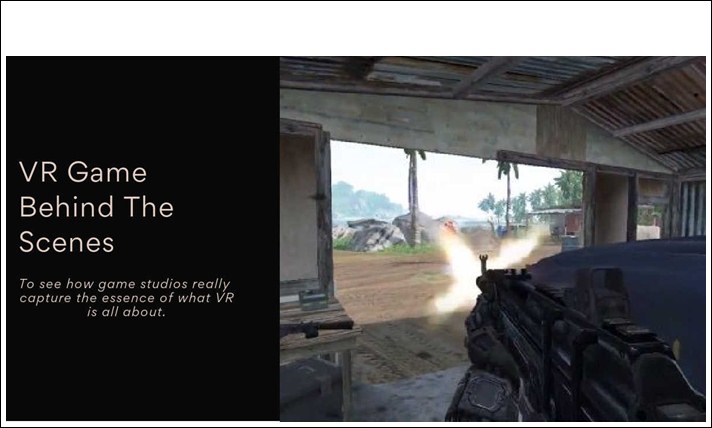
VR game: Behind the scenes
Creating a good VR game is marginally difficult – getting head tracking just right, and providing a truly immersive experience for players, rather than making them feel like they’re watching a movie through the VR headset. In this article, we’ll look behind the scenes of several VR game developments, to see how game studios really capture the essence of what VR is all about.
It isn’t just head tracking that’s important for VR – hand movement is equally important, so that players can interact with the VR environment in a meaningful way. That’s what the first company hoped to achieve in our first behind the scenes look in this article – Crytek’s The Climb.
The Climb was developed in partnership with Oculus, and who better to showcase the power of VR than Crytek, the company that gave us titles like Far Cry and Crysis? The Climb is a rock and mountain-climbing game with breathtaking scenery. Crytek put a lot of focus into capturing realistic detail – they had an indoor rock-climbing area setup inside their office and used it every day while working on The Climb.
This allowed Crytek to get a great feel for how to transfer elements of rock climbing into the game, such as proper hand placement – in fact, the VR head tracking feels secondary to the hand immersion, as you need to focus a lot more on the next ledge to grab, or quickly grabbing ledges while free-falling, rather than looking around – though if you do look around, the scenery truly is amazing, as you can expect from the CryEngine, and it can give a real sense of vertigo, especially if you’re someone afraid of heads.
While developing The Climb, the Crytek team noted that “traditional development approaches” (link: The Climb dev diary) didn’t work. It was incredibly important for audio, gameplay, and art to come together to create the truly immersive experience they were aiming for, and to try and cater to different playing styles – whether a player tries to climb slowly and methodically or scale the mountains as quickly as possible.
Another challenge for Crytek was performance – getting the game to run at 90 FPS. This was especially challenging for Crytek, being known for their games that push computer hardware to the limits. Thus, focus was put into optimization, which meant trying to reduce the number of in-game objects, while still delivering high quality scenery. This meant merging objects together to count as one, instead of several objects littering the scene, and using new texture mapping techniques.
So now we know how Crytek approached creating a VR-exclusive title, what about developers porting a game to VR? When Bethesda decided to port their popular title Fallout 4 to VR, they had numerous hurdles to overcome.
For starters, Bethesda needed to completely re-design the VATS system. Lead Producer Andrew Scharf had this to say about that process:
“In Fallout 4 you queue up your shots and a playback camera plays that shows all the carnage but that takes camera movement away from the player and that sort of thing can make you feel pretty uncomfortable in VR. So what we do instead is slow-down time and the player can teleport around in real-time. It’s like being Quicksilver from X-Men.”
They also tweaked various things to feel more realistic overall in VR – for example, immersion in the power armor. They reworked the power armor HUDs by placing the HUD more realistically where it would be if the player were wearing the helmet – as well as scaling the player up.
Another thing Bethesda addressed was how the player can interact with the workshop mode for settlements – with a controller or keyboard, players would scroll through items in the UI, and spend a lot of time clicking and dragging things around. Bethesda decided to completely revamp nearly everything about this in VR, by adding a lot of menus to the VR controllers, as well as object interaction.They also included a type of “laser tool” that the player can use for VR tracking (where you basically just point it in the direction of whatever objects you wish to demolish.)
This might work best for the VR adaptations of games like Tunnel Rush or Smash Hit: you don’t have to move around, simply target the obstacles and destroy them to avoid a collision and the game keeps up its pace. Quite the exercise for an evening!
Bethesda’s approach was to just simplify most things for VR, and sometimes a simple approach works best. There can be a lot of scope creep when doing a VR game project, and as the two examples in this article showed us, AAA studios really approach VR with a focus on providing immersion to the player in a simplified sort of way.
Read More : What VR system works with Xbox One? [Guide]
So, as we can see, making a good VR game really boils down to providing the best player immersion possible, while simplifying existing mechanics if it’s a game being ported to VR. For example, a fan-made remake of Five Night’s at Freddy’s not only focused on providing room-scale adaption, but also getting the Vive controller to be more user-friendly.
So for any would-be VR app devs reading this, whether you’re developing a PC exclusive title, or a remake of a particular popular games, take note – keep it simple and focus on an immersive experience, and the rest can fall into place.
Leave a Reply